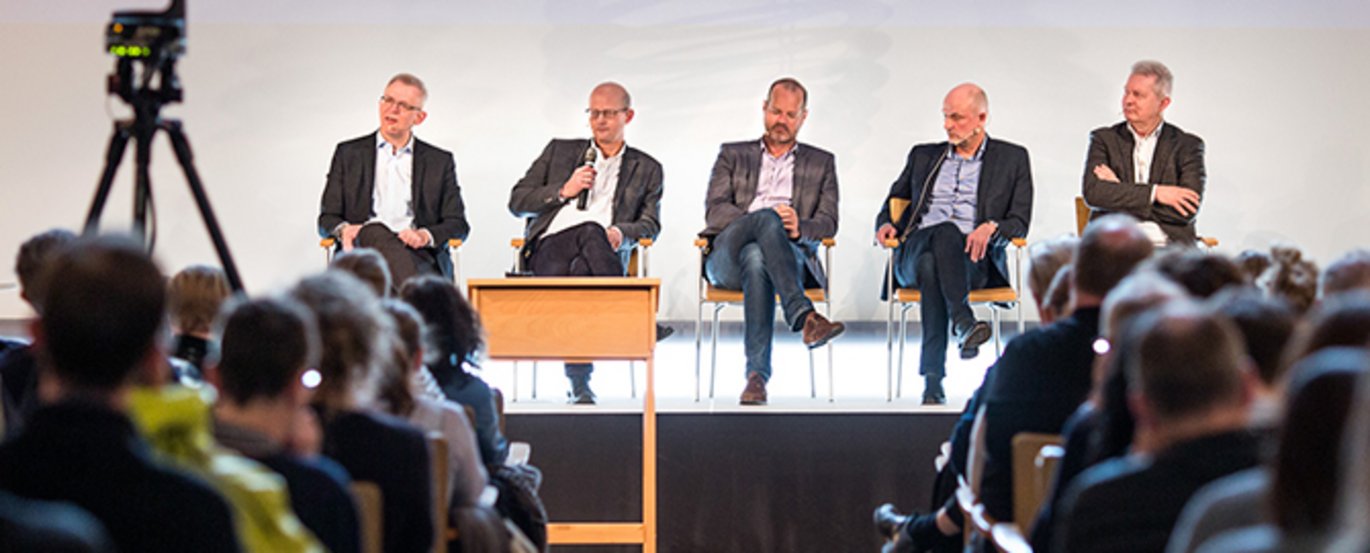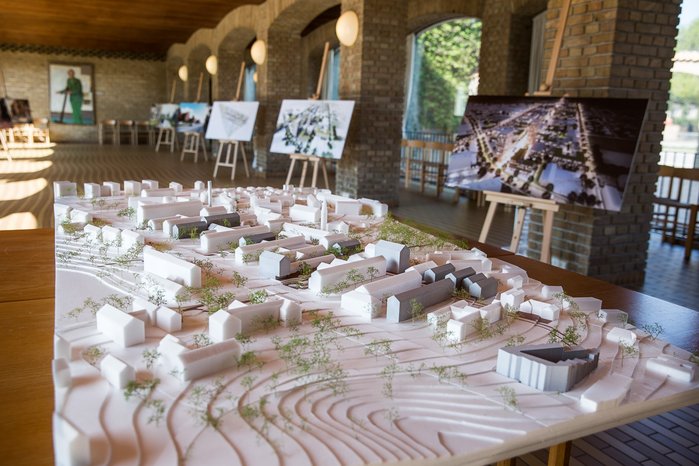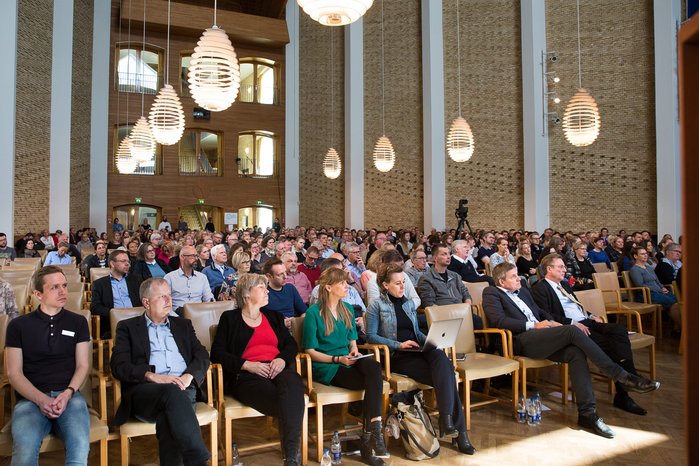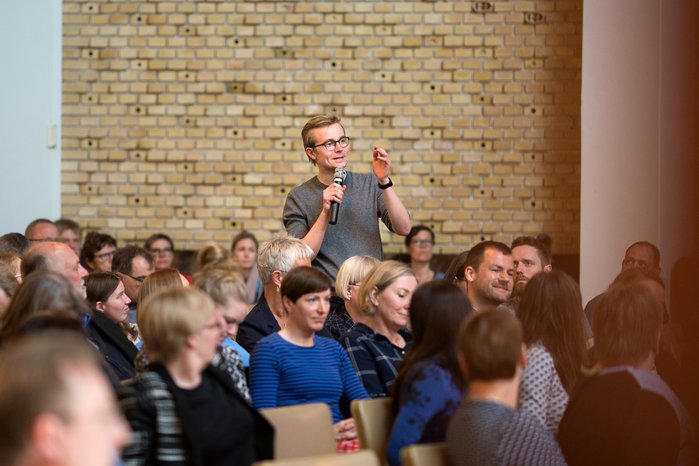Shoulder to shoulder for the AU of the future
On 2 May, the senior management team revealed its plans for the expansion of AU’s central campus over the next ten years into a full-blown ‘University City’.

AU is a respectable lady of mature years who will be turning 90 in September. But age has not slowed her down. And it won’t, even when she turns 100. On the contrary. This was made quite clear at a general meeting in the Main Hall on 2 May, when the senior management team’s members stood shoulder to shoulder to present their vision of how AU will consolidate its position in Aarhus. And in Denmark as a whole.

Posters and models of the two campuses were on display in the Ambulatory in connection with the general meeting in the Main Hall.
Rector Brian Bech Nielsen presented the vision for AU’s physical development. While the deans explained the long-term consequences the vision will have for students and employees at the four faculties. And yes, here ‘consequences’ means relocation. But for most, it’s too early to order removal boxes: the relocations will take place over the next decade.

The meeting in the Main Hall was well-attended.
The Nørrebrogade property
- In 2016, Forskningsfondens Ejendomsselskab A/S (FEAS) purchased the property and the hospital buildings on Nørrebrogade and leased them to AU.
- The property was purchased by Central Denmark Region for DKK 807.5 million.
- AU will pay rent to FEAS proportionate to the area the university occupies.
- Because the university is not a self-governing institution, AU could not purchase the property directly.
- The hospital will move its activities to the new hospital being constructed in Skejby.
- FEAS is a subsidiary of the Aarhus University Research Foundation (AUFF).
Campus 2.0 (AU.DK)
Master plan approved by the AU Board
The rector started out by stressing that the senior management team’s plans, which were approved at a meeting of the AU Board in mid-April this year, are based on the conviction that the campus will remain the central hub of the vibrant life of the university, even in the digital age.
This does not mean that the the senior management team has not noticed that digital methods of supporting learning are increasingly being used in teaching. Or that more and more degree programmes are being offered in cyberspace. However, the senior management team’s presentation of this aspect of the vision was so vague that it was difficult to grasp. The rector mentioned ‘blended learning’ as one example of a form of learning the senior management team is focused on. But in general, the rector and the deans stuck to very general descriptions of the strategic digitalisation initiative which is to be rolled out at Aarhus University in coming years.
We’re going to build a city...
On the other hand, the rector described the new campus on Nørrebrogade, which will be called the University City, in great and enthusiastic detail:
“We’re going to build a car-free city with housing, businesses and institutions where people will want to spend time even after the end of the working day.”
Rector Bech-Nielsen also revealed that the new University City campus will offer cafés as well as facilities for various forms of sport. Green recreational areas will also be accorded high priority.
250-500 new units of student housing
In relation to students’ housing options, the rector explained that the plan is to build 250-500 new units of student housing. Housing for researchers will also be built, and entrepreneurs will make their mark on the entire area.
“We want the place to buzz with initiative and enterprise,” as the rector put it.
 The chair of the Student Council at AU, Emil Outzen, was one of the participants who took advantage of the opportunity to ask the senior management team questions.
The chair of the Student Council at AU, Emil Outzen, was one of the participants who took advantage of the opportunity to ask the senior management team questions.
Changes on campus:
The University City
- The new campus area will be called ‘the University City’.
- The development of the University City will take place in five phases.
- Phase 1: Molecular Biology and Genetics moves from the science park to the University City (2019-21).
- Phase 2: Establishment of 250-500 units of student housing in the University City (approx. 2020-21).
- Phase 3: Student organisations and student activities are provided with facilities in the University City (approx. 2021-22).
- Phase 4: Aarhus BSS relocates from Fuglesangs Allé to the University City (approx. 2022-24).
- Phase 5: Arts moves from Kasernen to the University City (approx. 2024-25).
Kasernen, the science park, Navitas and Katrinebjerg
- Science and Technology takes over the vacated buildings at Kasernen and in the science park.
- Engineering programmes move from Navitas and are consolidated in Katrinebjerg.
AU outside Aarhus
- Food science activities in Årslev and Foulum move to a new building in Agro Food Park in Skejby.
- The Department of Animal Science and the Department of Agroecology will remain in Foulum.
- Activities in Silkeborg and Kalø will be relocated to Aarhus
- AU will remain in Roskilde.
The university board approved the vision for AU's physical development on 11 April 2018.
Farewell after 50 years on Fuglesangs Allé
Aarhus BSS Dean Thomas Pallesen announced that Aarhus BSS’ activities on the Fuglesangs Allé campus, which have been located there for 50 years, will relocate to the University City. The move will take place from 2022 to 2024. On the other hand, it will be business as usual at AU’s campus in Herning, according to the plans that were presented at the meeting. However, the senior management team plans to continue the development of the Herning campus as well.
Arts will vacate Kasernen
Faculty of Arts Dean Johnny Laursen gave the same message to the Danish School of Education (DPU) in Emdrup outside Copenhagen. There will be no major changes at DPU, although the campus will continue to see development. However, other departments at Arts will be going through a major revolution: Arts’ activities at Kasernen will relocate to the University City in 2024-25, announced Laursen.
The engineers will relocate after a short pitstop at Navitas
AU’s engineering activities at Navitas will be relocated to Katrinebjerg, announced Niels Christian Nielsen, dean of Science and Technology. He also announced that degree programmes in digitalisation, digital design and information studies will also move to Katrinebjerg. There are plans for a major redevelopment of Katrinebjerg, with new residential, commercial and recreational areas.
READ MORE: Aarhus architects to develop AU's new campus
AU will retain activities in Foulum – but not in Aarslev
Employees at AU’s Årslev campus have known about plans to relocate for quite some time. This also applies to some employees in Foulum: specifically employees affiliated with the food science activities which will relocate to Agro Food Park in Skejby. While the lease in Årslev will be terminated at the end of next year, very few employees will be asked to relocate from Foulum. The majority of the 700 employees will remain in Foulum.
AU employees in both Kalø and Silkeborg have also known that they will be moving to Aarhus at some point for quite some time. This will take place in connection with the university’s plan for physical development over the next decade.
READ MORE: The Spirit of the Yellow Brick
Least commotion at Health
Lars Bo Larsen, dean of the Faculty of Health, announced that his faculty would be least affected by the new plans. However, Health will be affected by the relocations, as it will have consequences for many at the faculty when the last doctors, nurses and patients move out to Aarhus University Hospital in Skejby next year.
Translated by Lenore Messick

